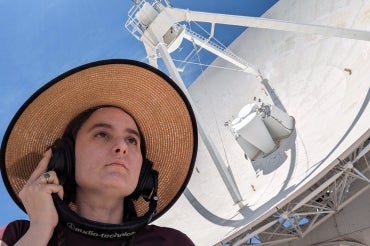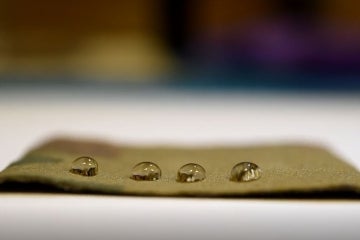'I love blowing people’s minds': Alum helps communicate space discoveries to the world

Kelly Lepo stands in front of a radio dish at the Very Large Array (VLA) at the National Radio Astronomy Observatory in New Mexico (photo courtesy of Kelly Lepo)
Published: August 17, 2023
Kelly Lepo likes to joke that she’s a real-life Lisa Simpson. Like the famous cartoon character known for her intellect and activism, the alumna of the University of Toronto’s Faculty of Arts & Science is a self-proclaimed “nerd” who will share her love of science with anyone who will listen.
“I love blowing people’s minds,” says Lepo, who earned her PhD from the David A. Dunlap department of astronomy and astrophysics in 2015 and is now an education and outreach scientist at the Space Telescope Science Institute in Baltimore, Md.
Lepo supports the James Webb Space Telescope by communicating the observatory’s discoveries to the world. She works at the same institute that oversees the famous spacecraft’s systems, schedules telescope time for scientists and records data.
Lepo says U of T was the perfect place to hone her public outreach skills as a TA and receive media exposure as a trusted expert in Canada’s largest astronomy department. She also learned how to educate large audiences and communicate complex theories about the universe.
“It’s an extraordinary experience learning from some of the top astronomers in a prestigious, yet nurturing environment,” says Lepo. “I remember the first time I landed in Toronto and it all sunk in that I was at one of the top universities in the world.”
During her PhD research, Lepo investigated stars that will explode as one type of supernovae to determine whether they were caused by two white dwarf stars colliding, or one star transferring its mass to another. She directed telescope operators in Chile and Australia to gather data from thousands of stars in the Small Megellanic Cloud, a tiny galaxy orbiting the Milky Way. In the end, she couldn’t find proof of supernovae caused by mass transfer, but her work was an important contribution to research in the field.
“In other studies, astronomers have used these supernovae to figure out the expansion history of the universe. They discovered our universe is not only expanding, but also accelerating in this expansion,” Lepo says. “Eventually, all galaxies are going to be so far away from each other that we're all going to be living in island universes.”
Her PhD adviser, Professor Marten van Kerkwijk, says Lepo was an efficient and driven astronomer.
“She has ample reason to be proud of her research,” says van Kerkwijk. “And I always appreciated the work she did while completing her PhD.”
In 2013, Lepo was a key organizer of the first ever West African International Summer School for Young Astronomers, a program partly sponsored by the Canadian Institute for Theoretical Astrophysics (CITA).
Lepo also cultivated her reputation as a trusted astronomy voice amid media coverage of the ancient Mayans' doomsday prophecy of 2012. Lepo debunked myths about killer solar flares and mysterious runaway planets on a collision course with Earth.
The experience complemented her TA duties in an Arts & Science class on the apocalypse, which took an interdisciplinary approach.
“We had someone from astronomy, someone from English and someone from sociology collaboratively teaching the course,” says Lepo. “That was really interesting to see how you could approach the same topic across several subjects.”
For her achievements inside and outside the classroom, Lepo won the Fieldus Award in 2014, given to one graduate student each year for excellence in leadership, teaching and research.
After graduation, Lepo taught physics at Gonzaga University before becoming the first co-ordinator of the McGill Space Institute at McGill University.
But she always ties her passion for public outreach back to U of T.
“One of my favourite memories is being in the middle of the St. George campus with a big inflatable sun and trying to get people to look at the sun safely through some solar telescopes; we must have come off as some kind of sun cult,” Lepo recalls.
“We explained to one person that the sun was much larger than the moon and they honestly had no idea, and this completely blew their mind. Those were the moments I really loved.”



